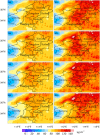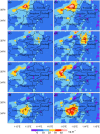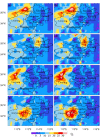Contribution of local and surrounding anthropogenic emissions to a particulate matter pollution episode in Zhengzhou, Henan, China
- PMID: 37253757
- PMCID: PMC10229599
- DOI: 10.1038/s41598-023-35399-8
Contribution of local and surrounding anthropogenic emissions to a particulate matter pollution episode in Zhengzhou, Henan, China
Abstract
In this study, we simulated the spatial and temporal processes of a particulate matter (PM) pollution episode from December 10-29, 2019, in Zhengzhou, the provincial capital of Henan, China, which has a large population and severe PM pollution. As winter is the high incidence period of particulate pollution, winter statistical data were selected from the pollutant observation stations in the study area. During this period, the highest concentrations of PM2.5 (atmospheric PM with a diameter of less than 2.5 µm) and PM10 (atmospheric PM with a diameter of less than 10 µm) peaked at 283 μg m-3 and 316 μg m-3, respectively. The contribution rates of local and surrounding regional emissions within Henan (emissions from the regions to the south, northwest, and northeast of Zhengzhou) to PM concentrations in Zhengzhou were quantitatively analyzed based on the regional Weather Research and Forecasting model coupled with Chemistry (WRF/Chem). Model evaluation showed that the WRF/Chem can accurately simulate the spatial and temporal variations in the PM concentrations in Zhengzhou. We found that the anthropogenic emissions south of Zhengzhou were the main causes of high PM concentrations during the studied episode, with contribution rates of 14.39% and 16.34% to PM2.5 and PM10, respectively. The contributions of anthropogenic emissions from Zhengzhou to the PM2.5 and PM10 concentrations in Zhengzhou were 7.94% and 7.29%, respectively. The contributions of anthropogenic emissions from the area northeast of Zhengzhou to the PM2.5 and PM10 concentrations in Zhengzhou were 7.42% and 7.18%, respectively. These two areas had similar contributions to PM pollution in Zhengzhou. The area northeast of Zhengzhou had the lowest contributions to the PM2.5 and PM10 concentrations in Zhengzhou (5.96% and 5.40%, respectively).
© 2023. The Author(s).
Conflict of interest statement
The authors declare no competing interests.
Figures











Similar articles
-
Contribution of local and surrounding area anthropogenic emissions to a high ozone episode in Zhengzhou, China.Environ Res. 2022 Sep;212(Pt C):113440. doi: 10.1016/j.envres.2022.113440. Epub 2022 May 6. Environ Res. 2022. PMID: 35526583
-
[One-year Simulation of Air Pollution in Central China, Characteristics, Distribution, Inner Region Cross-transmission, and Pathway Research in 18 Cities].Huan Jing Ke Xue. 2022 Aug 8;43(8):3953-3965. doi: 10.13227/j.hjkx.202111126. Huan Jing Ke Xue. 2022. PMID: 35971694 Chinese.
-
Effect of agricultural soil wind erosion on urban PM2.5 concentrations simulated by WRF-Chem and WEPS: A case study in Kaifeng, China.Chemosphere. 2023 May;323:138250. doi: 10.1016/j.chemosphere.2023.138250. Epub 2023 Feb 25. Chemosphere. 2023. PMID: 36849024
-
Spatial characteristics of the PM2.5/PM10 ratio and its indicative significance regarding air pollution in Hebei Province, China.Environ Monit Assess. 2021 Jul 10;193(8):486. doi: 10.1007/s10661-021-09258-w. Environ Monit Assess. 2021. PMID: 34245364 Review.
-
Concentrations, correlations and chemical species of PM2.5/PM10 based on published data in China: Potential implications for the revised particulate standard.Chemosphere. 2016 Feb;144:518-26. doi: 10.1016/j.chemosphere.2015.09.003. Epub 2015 Sep 19. Chemosphere. 2016. PMID: 26397469 Review.
Cited by
-
Spatiotemporal characteristic analysis of PM2.5 in central China and modeling of driving factors based on MGWR: a case study of Henan Province.Front Public Health. 2023 Dec 5;11:1295468. doi: 10.3389/fpubh.2023.1295468. eCollection 2023. Front Public Health. 2023. PMID: 38115845 Free PMC article.
References
-
- Sahu SK, Sharma S, Zhang HL, Chejarla V, Guo H, Hu JL, Ying Q, Xing J, Kota SH. Estimating ground level PM2.5 concentrations and associated health risk in India using satellite based AOD and WRF predicted meteorological parameters. Chemosphere. 2020;255:126969. doi: 10.1016/j.chemosphere.2020.126969. - DOI - PubMed
-
- Liu XM, Song HQ, Lei TJ, Liu PF, Xu CD, Wang D, Yang ZL, Xia HM, Wang TH, Zhao HP. Effects of natural and anthropogenic factors and their interactions on dust events in Northern China. CATENA. 2021;196:104919. doi: 10.1016/j.catena.2020.104919. - DOI
Grants and funding
LinkOut - more resources
Full Text Sources
Research Materials

